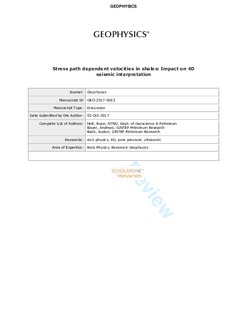| dc.contributor.author | Holt, Rune Martin | |
| dc.contributor.author | Bauer, Andreas | |
| dc.contributor.author | Bakk, Audun | |
| dc.date.accessioned | 2018-10-17T12:17:10Z | |
| dc.date.available | 2018-10-17T12:17:10Z | |
| dc.date.created | 2018-10-09T14:54:49Z | |
| dc.date.issued | 2018 | |
| dc.identifier.issn | 0016-8033 | |
| dc.identifier.uri | http://hdl.handle.net/11250/2568487 | |
| dc.description.abstract | Overburden stresses and pore pressure are altered by depletion or inflation of a subsurface reservoir, leading to seismic travel time and reflectivity changes that may be interpreted as footprints of reservoir drainage or injection. Our objective is to contribute to the quantification of expected 4D seismic timeshifts and reflectivities by understanding how overburden stresses and strains change, and how seismic velocities depend on these stress and strain changes. Stress sensitivity of ultrasonic velocities has been obtained from controlled laboratory experiments where field shale cores are brought to in situ conditions, and then probed with different stress paths, i.e. different ratios between horizontal and vertical stress change. The tests are performed in undrained conditions, and pore pressure changes are recorded. The experiments show that both velocity and pore pressure changes depend linearly on the stress path. The latter is a verification of the applicability of Skempton’s law from soil mechanics for shales. Overburden stress paths are, through analytical and numerical geomechanical modelling, seen to depend on the aspect ratio of the depleting or inflating zone, on elastic contrast between the overburden and the reservoir, and on reservoir tilt. By combining laboratory data and simulated overburden stress paths, the response of in situ wave velocities to reservoir pore pressure change can be estimated. Calculated in situ stress dependence of the vertical P-wave velocity shows significant dependence on stress path. The strain sensitivity, expressed by the dilation parameter, or R-factor, increases strongly with stress path. This expresses the explicit sensitivity of R to vertical in situ strain. The results also show that time-lapse overburden response may be significantly influenced by pore pressure changes in the overburden. | nb_NO |
| dc.language.iso | eng | nb_NO |
| dc.publisher | Society of Exploration Geophysicists | nb_NO |
| dc.relation.uri | https://library.seg.org/doi/10.1190/geo2017-0652.1 | |
| dc.title | Stress Path Dependent Velocities in Shales: Impact on 4D Seismic Interpretation | nb_NO |
| dc.title.alternative | Stress Path Dependent Velocities in Shales: Impact on 4D Seismic Interpretation | nb_NO |
| dc.type | Journal article | nb_NO |
| dc.type | Peer reviewed | nb_NO |
| dc.description.version | acceptedVersion | nb_NO |
| dc.source.journal | Geophysics | nb_NO |
| dc.identifier.doi | 10.1190/geo2017-0652.1 | |
| dc.identifier.cristin | 1619084 | |
| dc.relation.project | Norges forskningsråd: 234074 | nb_NO |
| dc.description.localcode | © 2018. This is the authors' accepted and refereed manuscript to the article. The final authenticated version is available online at: https://doi.org/10.1190/geo2017-0652.1 | nb_NO |
| cristin.unitcode | 194,64,90,0 | |
| cristin.unitcode | 194,0,0,0 | |
| cristin.unitname | Institutt for geovitenskap og petroleum | |
| cristin.unitname | Norges teknisk-naturvitenskapelige universitet | |
| cristin.ispublished | false | |
| cristin.fulltext | preprint | |
| cristin.qualitycode | 2 | |
